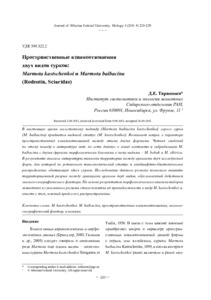Пространственные взаимоотношения двух видов сурков: Marmota kastschenkoi и Marmota baibacina (Rodentia, Sciuridae)
Скачать файл:
URI (для ссылок/цитирований):
https://elib.sfu-kras.ru/handle/2311/2720Автор:
Тараненко, Д.Е.
Taranenko, Dmitry E.
Дата:
2011-09Аннотация:
В настоящее время лесостепному подвиду (Marmota baibacina kastschenkoi) серого сурка
(M. baibacina) придается видовой статус (M. kastschenkoi). Возникает вопрос о характере
пространственных взаимоотношений между этими двумя формами. Четких сведений
по этому поводу в литературе нет, но есть данные о зонах контакта и гибридизации M.
baibacina с двумя другими морфологически близкими к нему видами - M. bobak и M. sibirica.
В результате анализа литературы выявлена территория между ареалами двух исследуемых
форм, для которой не установлен таксономический статус и ландшафтно-биотопическое
распределение обитающих здесь сурков. Исследование данного региона позволило выявить
территориальный разрыв между границами ареалов двух видов, обусловленный действием
эколого-географического фактора. На основе результатов морфологического анализа выборки
животных из указанного региона стала понятна их принадлежность к виду M. kastschenkoi и,
вместе с тем, южный предел его распространения. At present specialists consider forest-steppe subspecies (Marmota baibacina kastschenkoi) of a gray
marmot (M. baibacina) the separate species (M. kastschenkoi). There is appears the question about
the character of the spatial relationship between these two forms. There is no accurate data on this
point in the literature, at the same time, there is the information about the zones of the contact and
hybridization of M. baibacina with other morphologically similar to them species - M. bobak and
M. sibirica. Based on the review of the literature, we have revealed the territory between the areas
of the two investigated forms for which there is no any information about the taxonomic status and
landscape-biotopic distribution of the marmots inhabiting it. The investigation of this region made it
possible to establish the territorial gap between the borders of the areas of these two species, the reason
of which is the ecology-geographical factor. Basing on the results of the morphological analysis of the
mammals of the mentioned region we established their belonging to the species of M. kastschenkoi and
the southern bound of its distribution.

